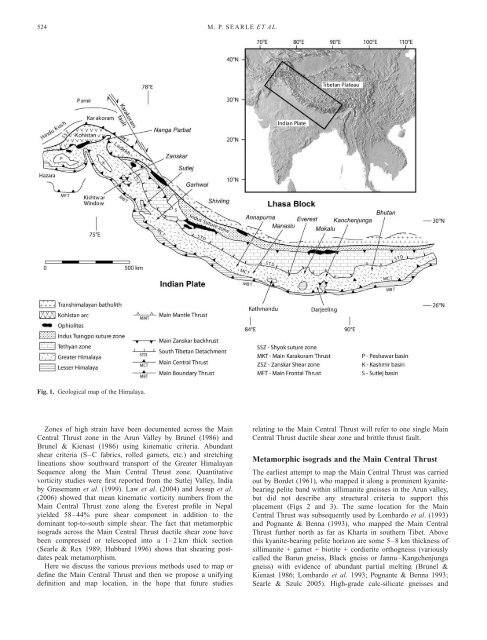Defining the Himalayan Main Central Thrust in Nepal - Queen's ...
Defining the Himalayan Main Central Thrust in Nepal - Queen's ...
Defining the Himalayan Main Central Thrust in Nepal - Queen's ...
You also want an ePaper? Increase the reach of your titles
YUMPU automatically turns print PDFs into web optimized ePapers that Google loves.
524<br />
M. P. SEARLE ET AL.<br />
Fig. 1. Geological map of <strong>the</strong> Himalaya.<br />
Zones of high stra<strong>in</strong> have been documented across <strong>the</strong> <strong>Ma<strong>in</strong></strong><br />
<strong>Central</strong> <strong>Thrust</strong> zone <strong>in</strong> <strong>the</strong> Arun Valley by Brunel (1986) and<br />
Brunel & Kienast (1986) us<strong>in</strong>g k<strong>in</strong>ematic criteria. Abundant<br />
shear criteria (S–C fabrics, rolled garnets, etc.) and stretch<strong>in</strong>g<br />
l<strong>in</strong>eations show southward transport of <strong>the</strong> Greater <strong>Himalayan</strong><br />
Sequence along <strong>the</strong> <strong>Ma<strong>in</strong></strong> <strong>Central</strong> <strong>Thrust</strong> zone. Quantitative<br />
vorticity studies were first reported from <strong>the</strong> Sutlej Valley, India<br />
by Grasemann et al. (1999). Law et al. (2004) and Jessup et al.<br />
(2006) showed that mean k<strong>in</strong>ematic vorticity numbers from <strong>the</strong><br />
<strong>Ma<strong>in</strong></strong> <strong>Central</strong> <strong>Thrust</strong> zone along <strong>the</strong> Everest profile <strong>in</strong> <strong>Nepal</strong><br />
yielded 58–44% pure shear component <strong>in</strong> addition to <strong>the</strong><br />
dom<strong>in</strong>ant top-to-south simple shear. The fact that metamorphic<br />
isograds across <strong>the</strong> <strong>Ma<strong>in</strong></strong> <strong>Central</strong> <strong>Thrust</strong> ductile shear zone have<br />
been compressed or telescoped <strong>in</strong>to a 1–2 km thick section<br />
(Searle & Rex 1989; Hubbard 1996) shows that shear<strong>in</strong>g postdates<br />
peak metamorphism.<br />
Here we discuss <strong>the</strong> various previous methods used to map or<br />
def<strong>in</strong>e <strong>the</strong> <strong>Ma<strong>in</strong></strong> <strong>Central</strong> <strong>Thrust</strong> and <strong>the</strong>n we propose a unify<strong>in</strong>g<br />
def<strong>in</strong>ition and map location, <strong>in</strong> <strong>the</strong> hope that future studies<br />
relat<strong>in</strong>g to <strong>the</strong> <strong>Ma<strong>in</strong></strong> <strong>Central</strong> <strong>Thrust</strong> will refer to one s<strong>in</strong>gle <strong>Ma<strong>in</strong></strong><br />
<strong>Central</strong> <strong>Thrust</strong> ductile shear zone and brittle thrust fault.<br />
Metamorphic isograds and <strong>the</strong> <strong>Ma<strong>in</strong></strong> <strong>Central</strong> <strong>Thrust</strong><br />
The earliest attempt to map <strong>the</strong> <strong>Ma<strong>in</strong></strong> <strong>Central</strong> <strong>Thrust</strong> was carried<br />
out by Bordet (1961), who mapped it along a prom<strong>in</strong>ent kyanitebear<strong>in</strong>g<br />
pelite band with<strong>in</strong> sillimanite gneisses <strong>in</strong> <strong>the</strong> Arun valley,<br />
but did not describe any structural criteria to support this<br />
placement (Figs 2 and 3). The same location for <strong>the</strong> <strong>Ma<strong>in</strong></strong><br />
<strong>Central</strong> <strong>Thrust</strong> was subsequently used by Lombardo et al. (1993)<br />
and Pognante & Benna (1993), who mapped <strong>the</strong> <strong>Ma<strong>in</strong></strong> <strong>Central</strong><br />
<strong>Thrust</strong> fur<strong>the</strong>r north as far as Kharta <strong>in</strong> sou<strong>the</strong>rn Tibet. Above<br />
this kyanite-bear<strong>in</strong>g pelite horizon are some 5–8 km thickness of<br />
sillimanite + garnet + biotite + cordierite orthogneiss (variously<br />
called <strong>the</strong> Barun gneiss, Black gneiss or Jannu–Kangchenjunga<br />
gneiss) with evidence of abundant partial melt<strong>in</strong>g (Brunel &<br />
Kienast 1986; Lombardo et al. 1993; Pognante & Benna 1993;<br />
Searle & Szulc 2005). High-grade calc-silicate gneisses and

















